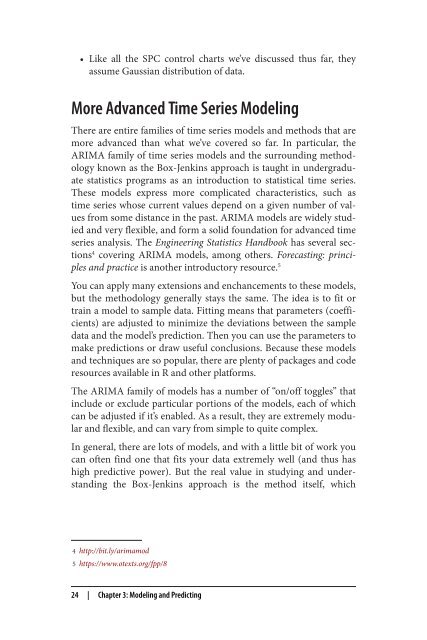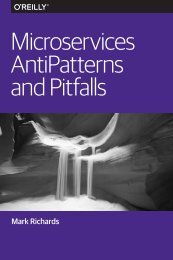Anomaly Detection for Monitoring
anomaly-detection-monitoring
anomaly-detection-monitoring
Create successful ePaper yourself
Turn your PDF publications into a flip-book with our unique Google optimized e-Paper software.
• Like all the SPC control charts we’ve discussed thus far, they<br />
assume Gaussian distribution of data.<br />
More Advanced Time Series Modeling<br />
There are entire families of time series models and methods that are<br />
more advanced than what we’ve covered so far. In particular, the<br />
ARIMA family of time series models and the surrounding methodology<br />
known as the Box-Jenkins approach is taught in undergraduate<br />
statistics programs as an introduction to statistical time series.<br />
These models express more complicated characteristics, such as<br />
time series whose current values depend on a given number of values<br />
from some distance in the past. ARIMA models are widely studied<br />
and very flexible, and <strong>for</strong>m a solid foundation <strong>for</strong> advanced time<br />
series analysis. The Engineering Statistics Handbook has several sections<br />
4 covering ARIMA models, among others. Forecasting: principles<br />
and practice is another introductory resource. 5<br />
You can apply many extensions and enchancements to these models,<br />
but the methodology generally stays the same. The idea is to fit or<br />
train a model to sample data. Fitting means that parameters (coefficients)<br />
are adjusted to minimize the deviations between the sample<br />
data and the model’s prediction. Then you can use the parameters to<br />
make predictions or draw useful conclusions. Because these models<br />
and techniques are so popular, there are plenty of packages and code<br />
resources available in R and other plat<strong>for</strong>ms.<br />
The ARIMA family of models has a number of “on/off toggles” that<br />
include or exclude particular portions of the models, each of which<br />
can be adjusted if it’s enabled. As a result, they are extremely modular<br />
and flexible, and can vary from simple to quite complex.<br />
In general, there are lots of models, and with a little bit of work you<br />
can often find one that fits your data extremely well (and thus has<br />
high predictive power). But the real value in studying and understanding<br />
the Box-Jenkins approach is the method itself, which<br />
4 http://bit.ly/arimamod<br />
5 https://www.otexts.org/fpp/8<br />
24 | Chapter 3: Modeling and Predicting




